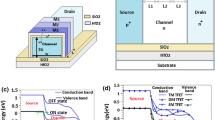Abstract
To meet the stringent demands of high quality gate performance in advanced devices, a more robust gate dielectric is needed. A stacked structure consisting of thermal oxide and deposited oxide is a potential candidate since it offers certain advantages over single layer oxides such as 1) reduced defect density, 2) reduced stress at the SiO2/Si interface due to stress compensation between the thermal and the deposited oxide, 3) less silicon consumption and 4) reduced thermal budget. In this study, stacked oxides consisting of RTO and RTCVD oxides are characterized. In contrast to other studies which use conventional LPCVD methods to form the top oxide, these stacked oxides have the advantages of rapid thermal and in-situ processing, which produces excellent bulk and interfacial properties. Electrical characterization has shown that these stacked oxides have superior performance compared to single layer furnace or deposited oxides.
Similar content being viewed by others
References
J. Lee, I.-C. Chen, and C. Hu, “Comparison between CVD and thermal oxide dielectric integrity”, IEEE Elect. Dev. Letts, vol EDL-;7, no 9, Sept 1986.
W. Ting. P.C. Li, G.Q. Lo and D.L. Kwong, “Effects of rapid thermal oxidation on electrical characteristics of chemical-vapor-deposited SiO2 gate dielectrics”, J. Appl. Phys. vol 66, no 11, Dec 1989.
D.W. Freeman, “Thin-gate low-pressure chemical vapor deposition oxides”, J. Vac. Sci. Technol. A, vol 5, no 4, July 1987.
P.K. Roy, A.K. Sinha, “Synthesis of High Quality Ultra-Thin Gate Oxides for ULSI Applications”, AT&T Technical Journal, Nov/Dec 1988.
R. Moazzami, C. Hu, “A High Quality Stacked Thermal/LPCVD Gate Oxide Techonlogy for ULSI”, IEEE Electron Dev. Lett., Vol 14, no 2 Feb 1993.
H.-H. Tseng, P.J. Tobin, J.D. Hayden, K.-M. Chang, J.W. Miller, “A Comparison of CVD Stacked Gate Oxide and Thermal Gate Oxide for 0.5μm Transistors Subjected to Process-Induced Damage”, IEEE Trans on Electron Dev, Vol 40, no 3, March 1993.
A.J. Bauer, J. Wang, W.R. Aderhold, E.P. Burte and H. Rysell, “Electrical properties of thin reoxidized dual-layer oxides”, Thin Solid Films, vol 230,1993.
H.-H. Tseng, P.J. Tobin, “Thin CVD Stacked Gate Dielectric for ULSI Technology”, IEDM Tech Digest, 1993.
X.L. Xu, R.T. Kuehn, J.J. Wortman and M.C. Öztürk, “Rapid thermal chemical vapor deposition of thin silicon oxide films using silane and nitrous oxide”, Appl. Phys. Lett. vol 60, no 24, June 1992.
Author information
Authors and Affiliations
Rights and permissions
About this article
Cite this article
Misra, V., Xu, XL. & Wortman, J.J. Electrical Properties of Stacked RTO/RTCVD Oxides as Gate Dielectrics. MRS Online Proceedings Library 342, 187–193 (1994). https://doi.org/10.1557/PROC-342-187
Published:
Issue Date:
DOI: https://doi.org/10.1557/PROC-342-187




